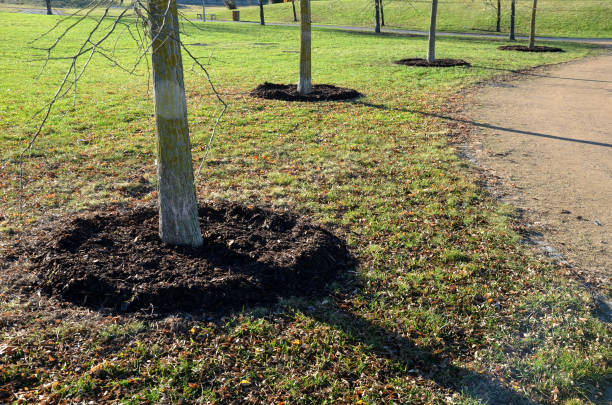Proper techniques for mulching around trees can significantly improve the health and appearance of your landscaping. Ensuring the mulch is spread correctly benefits the tree and contributes to the overall ecosystem of your garden. Understanding the nuances of mulching can elevate your tree care routine and set the stage for a flourishing outdoor environment.
So, let’s explore the nuances of this essential task and uncover the secrets to successful tree mulching.
Importance of Mulching
Mulching around trees enhances soil moisture retention and aids in weed suppression. By creating a barrier between the soil and the air, mulch helps lock in essential moisture, keeping the soil around your trees hydrated for extended periods. This is especially beneficial during hot, dry weather when water evaporates quickly. Additionally, mulch is a natural weed barrier, preventing weeds from sprouting and competing with your trees for nutrients and water.
Furthermore, mulch provides soil insulation, helping regulate its temperature. This is crucial in protecting the roots of your trees from extreme temperature fluctuations, which can harm their health. Mulching also encourages beneficial soil organisms like earthworms, which help to aerate the soil and improve its overall quality.
In essence, mulching is a simple yet effective way to support the health and growth of your trees. By investing a little time and effort into mulching, you can reap the rewards of healthier trees and a more vibrant landscape.
Types of Mulch
Different types of mulch offer various benefits and considerations for effectively nourishing your trees. When choosing mulch, consider the tree species, local climate, and your landscaping goals.
Organic mulches, like wood chips, bark, and leaves, decompose over time, enriching the soil and providing nutrients to the trees. They also help retain moisture and regulate soil temperature. Inorganic mulches like rocks, gravel, and rubber do not decompose and can offer longer-lasting weed control. However, they do not provide nutrients to the soil.
You may also opt for mulches that serve specific purposes. For example, pine straw is acidic and suitable for acid-loving plants like azaleas. Cocoa hull mulch adds a pleasant aroma to your garden but can be toxic to pets if ingested.
When selecting mulch for your trees, consider the appearance, functionality, and maintenance requirements. Experiment with different types to find the one that best suits your needs and promotes the health and growth of your trees.
Proper Mulching Techniques
When considering mulching around trees, it is essential to understand the proper techniques that will benefit their health and growth. Proper mulching techniques can make a significant difference in their overall well-being. First, ensure the mulch is spread evenly around the tree, creating a donut shape with the tree trunk in the center. This helps retain moisture, regulate soil temperature, and prevent competing weeds from growing.
Remember not to pile mulch against the tree trunk, leading to moisture issues and even rot. Leave a small gap around the tree’s base for proper air circulation. When applying mulch, aim for a thickness of about 2-4 inches, making sure not to exceed this depth. Mulch piled too thickly can suffocate the tree roots and hinder their growth. Lastly, refresh the mulch annually to maintain its benefits and keep your trees healthy and thriving.

